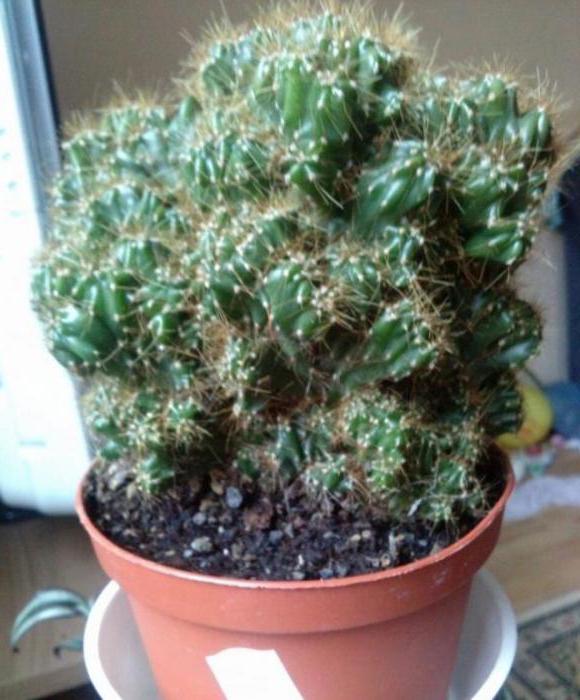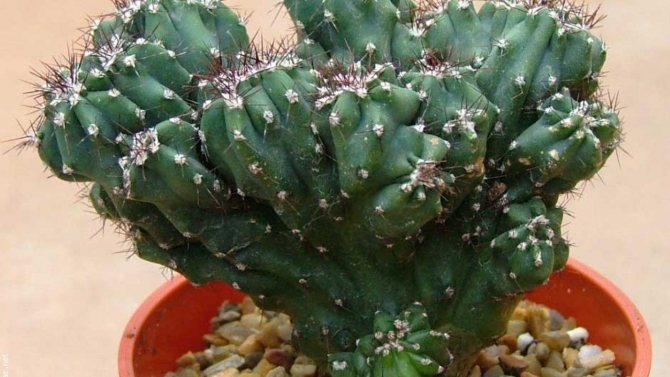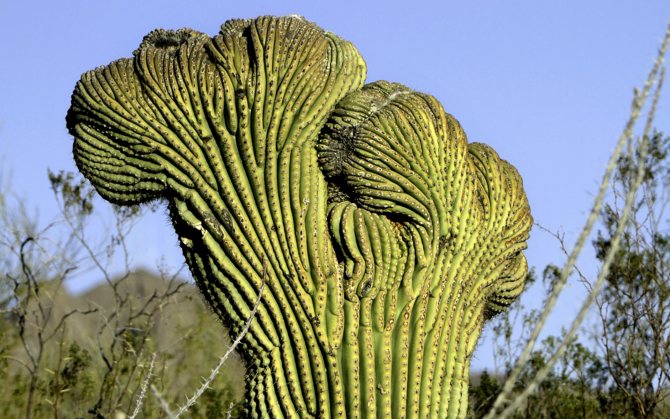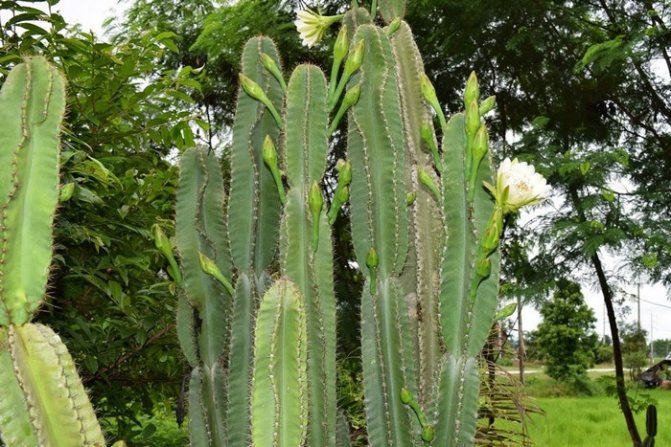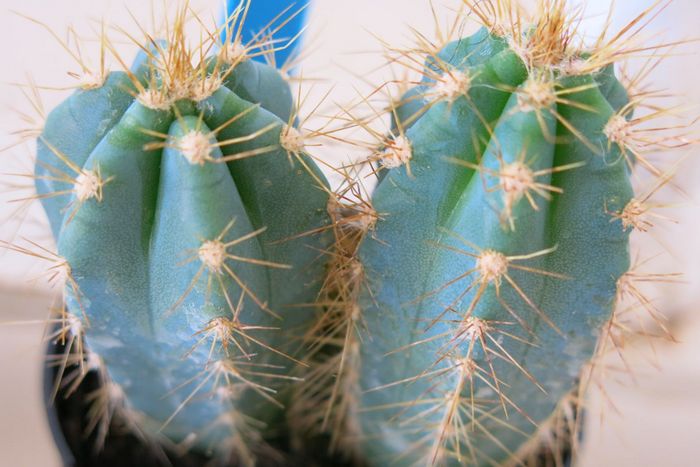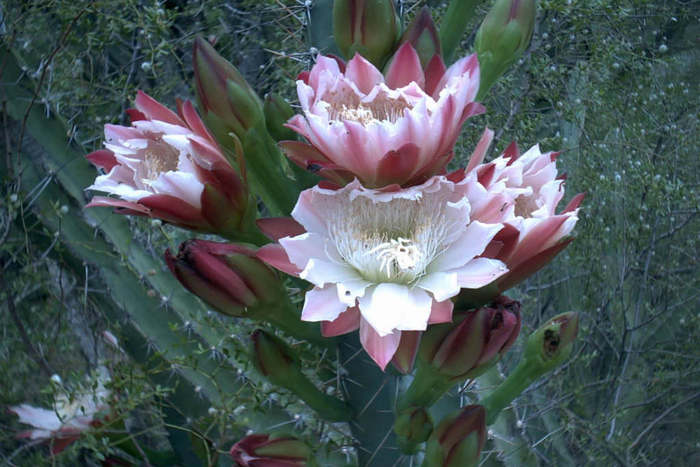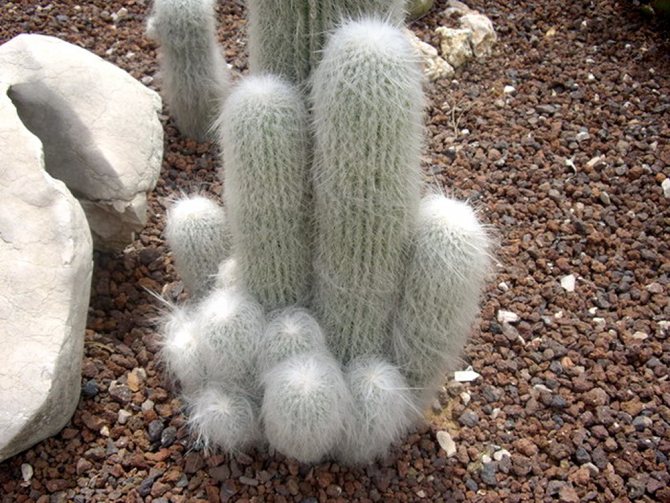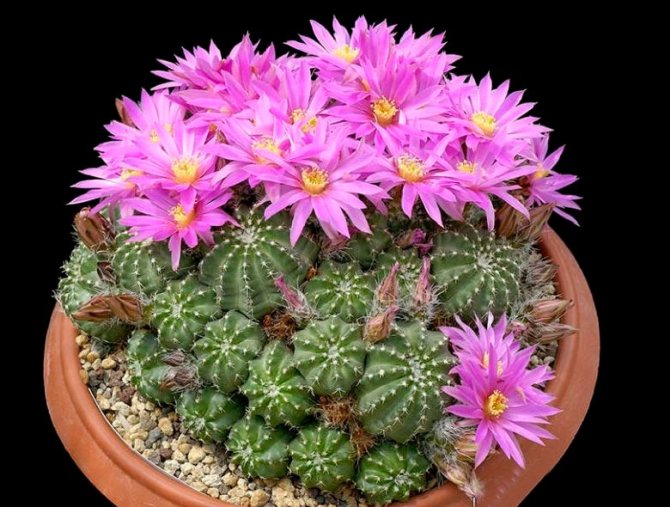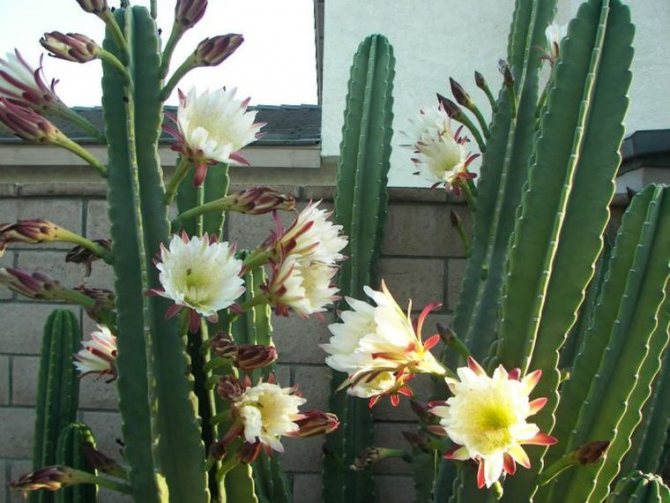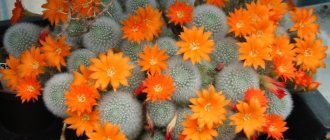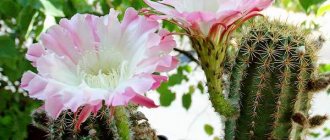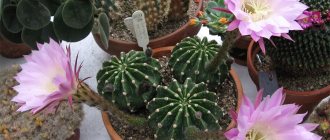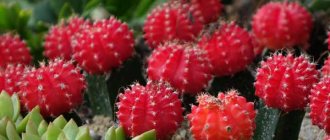Cereus ("Cereus" translated from Latin means "Wax candle"). It differs from other types of cacti in its size, usually an adult plant is from 10 to 20 meters in height. This type of cactus is considered a long-liver - some species are more than 300 years old.
Cereus cactus, like all succulents, has the property of accumulating moisture in its own stem, which makes it possible for the plant to survive in almost any conditions. Cereus came from the edges of Central or South America, as well as the West Indies. Grows in the form of pillars in rocky terrain.
Read an article about different types of cacti with photos and descriptions
Cactus cereus repandus
Cereus are the most famous columnar cacti. They have long been common in culture, beautiful and undemanding. Of the several dozen species, most are so large plants that they are almost unsuitable for growing in houses, and therefore only a few representatives of the genus are widespread in culture. But unlike cephalocereus, you can even admire the flowering of some species of cereus at home.
The most famous of them - Cereus repandus (C. repandus = C. peruvianas) - can bloom at the age of several years (if grown from a cuttings) at a height of about half a meter.
As you can see in the photo, this Cereus cactus has a flower about 16 cm long, daytime, white:
Cereus plants need spacious dishes, a nutritious earthy mix, and plenty of light to grow properly. Cereus is a favorite object of phytodecorators. And collectors are engaged in the care of cacti, cereus at home, mainly for use as rootstocks.
Photo
In the photo you can see vivid representatives of the Cereus cactus species, such as Peruvian, Monstrous (rocky):
Types of rocky cereus
Rocky cereus have firmly taken pride of place among common indoor flowers due to their bizarre shape, vitality and longevity. "Rocky" is not a specific or varietal name, but a designation of a growth form. Rocky or monstrous plants are found among the normal plants of many cactus species. But rocky cereus are most common. It is believed that two types of rocky forms are common in culture - Cereus repandus (= peruvianus) and C. jamacaru (yamakaru). However, it is quite probable that forms of other species are found among the "monstrous" diversity. It is very difficult to clarify the species belonging of a particular rocky cereus, since the characters used in taxonomy are practically not expressed in rocky forms.
When describing this cereus cactus, it is worth noting that the rockiness of the form is already manifested in tiny seedlings. But sometimes (and precisely in Cereus) monstrosity begins to form in adults, until then quite normal plants - on a new growth (apical or lateral).
Indoor rocky cereus propagate exclusively vegetatively. After drying, neatly cut and broken off pieces take root easily. It is important to cut the stem off so that the remaining scar does not spoil the mother plant.
Rocky Cereus is very diverse in appearance. They can be predominantly columnar or strongly branched, with many small tubercles or with large, far-apart protuberances, with powerful spiny or thin corymbose spines of various colors. These plants live for a long time and do not lose their decorative effect with age.
Look at the photo - Cereus cacti can reach solid sizes, or, like bonsai, they can maintain an unnatural miniature size:
Rocky cereus steadfastly endure unfavorable conditions, under which for several years without visible damage to themselves they can stop growing, and then, as if nothing had happened, continue to develop. If - which happens very rarely with these plants - some shoots of rocky cereus "stretch" due to lack of light, the general quirkiness of the form conceals the emerging flaws. The rocky shape hides both scars and traces of disease. All this ensures the widespread use of rocky cereus for decorative purposes.
Blooming cactus Astrophytum head-medusa (Astrophytum caput-medusae)
The appearance of a cactus Astrophytum jellyfish head
matches the name. Cactus is really something
resembles the head of mythical creatures of jellyfish
who had snakes on their heads instead of hair. This type of cactus is from the genus
Astrophytum
opened relatively recently -
in 2002
- and at first they thought that he belongs to a separate genus because of his unusual appearance.
10 most beautiful flowers in the world

However, later it turned out that the flowers of this cactus are identical to the flowers of other species of the genus. Astrophytum
, as well as the tufts of soft hairs that grow on the stems. Cactus
A. caput-medusae
blooms with beautiful yellow flowers with a red center and gives one of the largest seeds among cacti -
about 0.3 - 0.6 centimeters
in diameter.
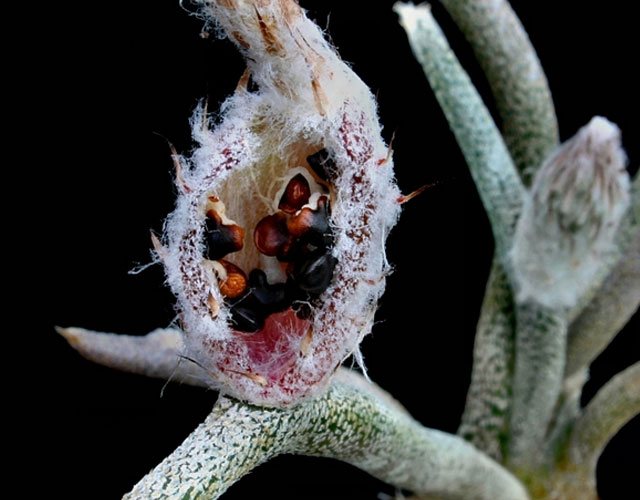

Caring for Rocky Cereus
Caring for Rocky Cereus Cactus is pretty simple. If you want to get a large plant, the soil should be nutritious, with a slightly higher content of the clay-sod component. Cereus are fast-growing cacti and respond well to abundant cacti during the growth period, as well as periodic spraying and watering with a weak solution of mineral fertilizers. The stems of these plants can be washed under running warm water.
Rocky Cereus tolerate prolonged exposure to low light conditions (which is why they are often used in interiors). But for normal development, these plants need a lot of sunlight, especially in summer. At least, at the southern or southeastern window, and better - outdoors or in a greenhouse (however, brought out into the open sun without prior preparation, the rocky cereus can be seriously burned).
The name "Cereus" is translated from Latin as "wax candle"
.
Tall cacti
, comparable to the height of a person, decorate winter gardens, greenhouses and halls of various institutions. They are often used for window dressing.
Low varieties of Cereus are bred as domestic plants.
Cereus: what is known about him?
Cereus is a succulent like other cacti. A lot of moisture is stored in its juicy trunk. The pulp is hidden under thick skin with a dense wax coating.
South America and Western India are considered the birthplace of Cereus. From the Latin alphabet, the name "Cereus" is interpreted as "wax candle", they are also called "desert torches" and "candlesticks". Such "fiery" names appeared thanks to travelers who set fire to the trunks of old cacti. The dried pieces of plants burned perfectly and illuminated the desert for a long distance.
Cactus in the wild
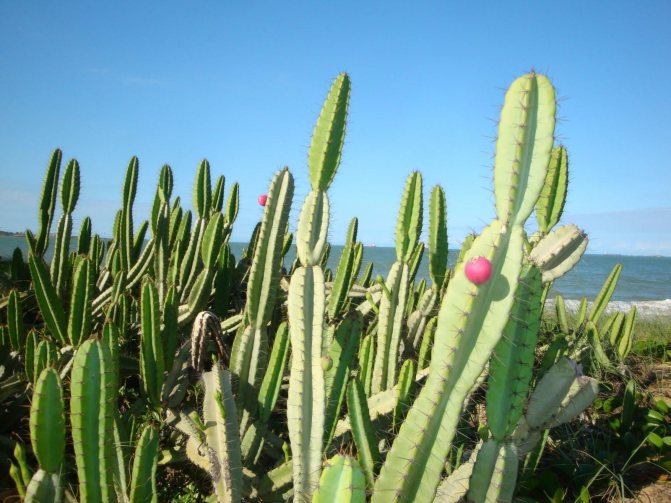

In some species of Cereus, flowers open at night!
In the wild, the cereus is considered a giant. Usually it reaches 6-10 meters in height, and some specimens stretch up to 20 meters. In addition, this cactus is a long-lived record holder that lives up to 300 years. By the age of 50, it reaches its maturity, and between 75 and 100, branches begin to appear on the huge trunk. Moreover, the number and location of branches varies greatly, so it is unlikely that it will be possible to find two identical cacti.
Interesting! The "cactus thickets" in the Mexican deserts make an indelible impression on tourists. These are giant pillars up to 15 meters high and half a meter thick, which branch out from the middle in the form of a candlestick.
Signs and superstitions
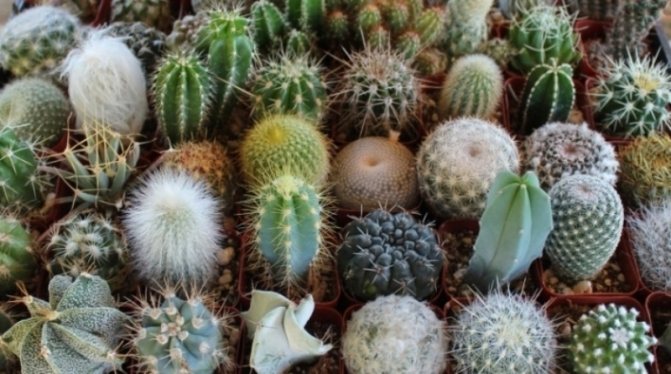

Cactus growers do not believe in bad omens, but they just happily breed a variety of pets.
All cacti, including Cereus, have amazing energy and almost magical properties. They hide the essence of Yang and the essence of Yin, therefore cacti are considered universal helpers for people. For example, a cereus can be placed at the front door to protect the house from negative energies and burglars.
But at the same time, cacti are very fond of places with poor energy. If quarrels and negativity reign in the family, the plant will grow rapidly, actively branch and live a long time. Therefore, do not be discouraged if cacti do not take root in you: this means that the atmosphere in the house is good.
Who is it for
Cereus cultivation is possible even for beginners. The plant is non-poisonous, its fruits are even eaten. But there are two features that a florist should be aware of:
- Cactus flowers have a very strong aroma. In sensitive people, it can cause insomnia and headaches.
- Cactus needles grow very quickly. If it is in a small room, small children and animals could be injured.
Flowering features
Cereus in nature bloom mainly in May and June
... All of their species belong to night flowering cacti. The arrangement of flowers is lateral, that is, on the lateral side of the stem. In almost all species, flowers are large, white, often with a golden center. They smell nice, sometimes the smell is quite strong, in some species it resembles the smell of vanilla.
Flowers open at night. Unfortunately, they are short-lived and fade within 24 hours.
In nature, on a large plant, several flowers often open simultaneously or sequentially; at home, this is a rarity.
It is believed that when breeding at home, Cereus does not bloom at all. The fact is that for these cacti plays a huge role good lighting and long daylight hours
... In unfavorable conditions, they really will not bloom or will bloom extremely rarely.
Here are the main reasons preventing the flowering of Cereus at home
:
- Insufficient lighting.
- Lack of adequate rest in winter.
- Too young age.
- Improper care: violation of temperature and humidity conditions, lack of fresh air.
With sufficient light and proper watering, homemade Cereus bloom in late spring - early summer. At the same time, there are cases when Cereus bloomed in autumn.
Bloom
The flowering period begins from early spring to early summer. In most species of Cereus, flowers bloom at night, emitting a pleasant aroma.
During this period, the plant needs good lighting and moderate watering. You should also not forget about fertilization. This will help prolong the flowering period of the cactus.
Views
Cereus peruvian (Cereus peruvianus)
Other name - Cereus rocky
... Cylindrical gray-green stem with pronounced ribs. At home, it grows about 50 cm in height, less often - up to 1 meter. The flowers are white, large. They usually open for just one night, they have a rather strong pleasant smell. The fruit is an edible berry, most often red or orange in color.
Photo of Peruvian Cereus and its flower.
A special form of Peruvian Cereus is called monstrous
... The stem takes on bizarre curved shapes, but this attracts many amateurs with its decorative effect.
Cereus repandus
According to most sources, this is not a separate species, but the second name for the Peruvian Cereus.
Cereus jamacaru
Columnar cylindrical stem, decorated with light spines. Flowers bloom at night. Not unusual flowers with a diameter of about 20 cm
.
Cereus giant (desert giant)
Distributed in the territory
states of California, Arizona, Texas.
Listed in the Guinness Book of Records as tallest cactus in the world
: 25 meters.
The Giant Cereus flower is the symbol of the state of Arizona.
Unlike many other cacti, Cereus the giant's growth rate increases after 30 years. The shape of its trunk changes, numerous lateral processes appear. Younger cacti grow very slowly.
Cereus giant fruit
- edible, these are juicy and tasty bright red berries.
Cereus validus
Straight branching stems
, at an early age - bluish. The number of ribs is from 4 to 8. The flowers are white.
Cereus uruguayan
Columnar stem
with 5-8 ribs, bluish-green color. Sharp spines up to 2 cm long.
Cereus azure
Named so for bluish stem
... Powerful in appearance, the dark stem can be highly branching. Ribs not numerous, poorly expressed. The flowers are white with a strong aroma.
Cereus species with photos and descriptions
To date, 48 species of cereus are known.
Consider the types that are popular in indoor growing:
Cereus Peruvian Cereus peruvianus


In nature, Cereus peruvianus branches well and takes the shape of a tree 8-10 m high. Stems are green with a bluish tint. Ribs 5-8-10 pieces. The flowers are snow-white.
Origin and habitat:
South America, widely used as a hedge and as an ornamental plant, therefore, it is difficult to find out the natural origin; it is probably native to the western Caribbean and Venezuela (or Brazil). This species is common in tropical and subtropical gardens around the world, has been planted commercially as an agricultural plant for small-scale fruit harvesting in the Netherlands Antilles, other Caribbean, Mexico, Israel and the United States, and is distributed as a wild plant after abandoned crops. It is considered a weed in South Africa.
Description:
Peruvian apple cactus
Cereus repandus
, which is most often known by the name
Cereus peruvianus
, is a tall, powerful columnar cactus well known to cactus lovers around the world. It is grown primarily as an ornamental plant, but has some local culinary significance and is probably the most widely grown species.
Its perennial tree-like stem is quite succulent, often with many upright or slightly curved branches, often with clear trunks up to 10 m (but usually smaller).
Stems:
cylindrical, somewhat slender, segmented, gray-green and blue, 10 -20 cm in diameter.
Ribs:
9-10, small, rounded, somewhat compressed, up to 1 cm in height.
Areolas:
small, widely spaced.
Spikes:
Extremely variable, often numerous, sometimes absent, gray, needle-like, up to 5 cm long.
Flowers:
Nocturnal, each flower opens for just one night and then shrivels, white with reddish tips, 12-15 cm long. It requires cross-pollination to produce fruit.
Bloom season:
During the warm season
Cereus peruvianus
blooms several times.
Fruits:
The fruit, known as the "Peruvian Apple" or "Cubo", is globular, elongated up to 4 cm in length, without thorns, usually red with white flesh, but the skin color ranges from yellow to deep purple-red. The edible pulp is white and contains small, edible, crunchy seeds.
The fruit tends to crack during ripening, and the pulp is sweetened when the fruit is fully opened. The optimal stage of harvest is when the fruit is close to full ripeness. Once harvested, the ripe fruit must be eaten within twenty-four hours, or they begin to ferment. Fruits grow and ripen for about 40-50 days, so flowers and fruits often appear on the cactus. One large cactus can produce hundreds of fruits every year.
Cereus monstrous or rocky Cereus monstruosus


In the monstrose cereus, the lateral processes can grow together and form a bizarre bush, and the size is also enormous.
The native species is used to form hedges. In the past, it was used as wood, cut for construction and planks suitable for boxes, picture frames, etc., made drinking utensils. In most houses, earlier, this cactus was used to build roof fortifications on which shingles were laid. During times of great drought, farmers cut off young branches from these cacti to feed their livestock. The fruit is edible.
Cereus jamacaru or hakamaru Cereus jamacaru
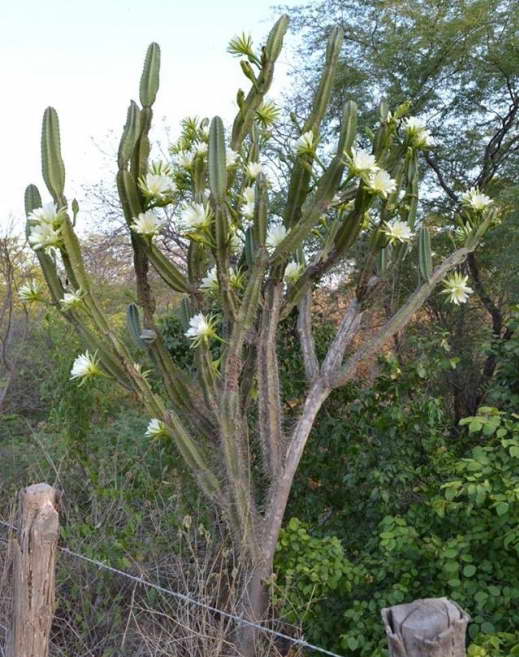

Origin and Habitat: Cereus jamacaru is found in northeastern Brazil in Alagoas, Sergipe, Bahia, Maranhao, Pernambuco, Goias and Minas Gerais. Listed in the West Indies; possibly naturalized on some islands.
Altitude range: grows from 50 to 1200 meters above sea level.
Growing Conditions: This cactus grows in all situations from coastal to inland desert in both rocky and sandy soil and on rocks of various kinds. The species can be aggressive, crowding out other plants. Subpopulations of Cereus jamacaru have declined and continue to do so mainly due to habitat loss. In protected areas, it has the ability to recover after the destruction of the distribution areola. Cereus jamacaru has also been introduced outside of its own ranges and has become invasive.
Description: Cereus jamacaru is a large tree-like cactus up to 10 meters high, with a short, thick wood stem, very branched, branches usually ascending, numerous, often forming a compact top. Living in dense forests, it has a simple stem or only a few branches growing high and straight, the branches have few ribs, but they are tall, blue below, covered with formidable thorns up to 20 cm long.The flowers are large and white, the buds usually appear in mid-spring and each flower only lasts one night. Cereus Yamakaru blooms at dusk and its flowers wither by morning. Its fruit is deep purple in color. The flesh is white with tiny black seeds and is considered delicious.
Stem: the main trunk is erect, woody, up to 60 cm in diameter. The branches are cylindrical, segmented, young with a blue tint, up to 15 cm in diameter, with several (4-6) ribs; the ribs of young branches are thin, compressed, high, more or less wavy, up to 3.5 cm in height.
Areoles: Large, gray, 2 to 4 cm apart, separated by notches.
Thorns: different, on old stems and branches numerous, awl-shaped, at first yellow or brown, later black, often very long, from 20 to 30 cm long.
Central spines: 2-4, 8-20 (or more) cm long.
Radial spines: 5-7, up to 1.5 cm long.
Flowers: nocturnal, lateral, oblique, very large (up to 30 cm in length, 18-20 cm in diameter), white; purple pistil with several brown scales; the lobes are numerous, 2 cm long. Fruits: large, sometimes 12 cm long by 8 cm in diameter, bright red, splitting down on one side, revealing white edible flesh. Seeds: 3 mm long, dull, rough with blunt tubercles.
Cereus giant or desert giant Cereus grandicostatus
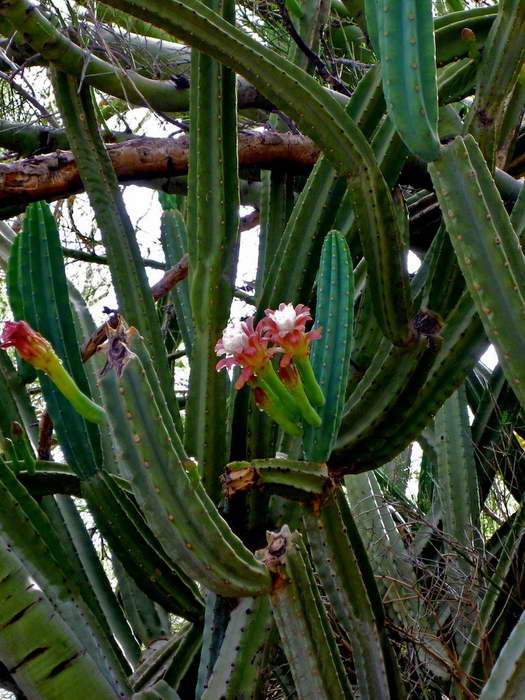

Cereus giant or desert giant Cereus grandicostatus photo in nature
Listed in the Guinness Book of Records as the largest cactus in the world. It is able to grow to a height of 20 m. The first 30 years of life, it is modest, but after this milestone it begins to release many side shoots and quickly gains in growth. The plant is the national symbol of the state of Arizona.
Cereus forbes spiral Cereus forbesii spiralis
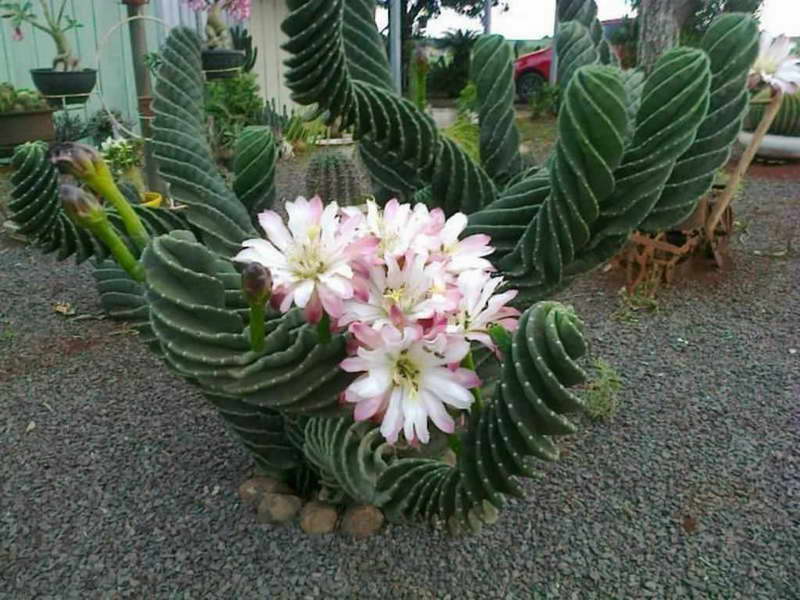

The stem is really twisted in a spiral. Flowers appear on the sides, the petals are snow-white with pink edges.
It is a shrub or arboreal species, doubtfully considered a mutant of Cereus forbesii. It is a cactus that forms numerous tall, ascending, columnar stems that branch out at the base in the form of a candelabra. The stems have a waxy coating on the surface and reach a height of 2-4 meters (but can grow up to 5 m or more) and have a diameter of 10 to 12 cm. They have five to nine widely spaced ribs.
This species tolerates short-term frost down to -2 ° С. Requires a well-drained potting mix.Regular watering is required in the summer, but the land may dry out completely before watering. Dry maintenance is required during the winter months. Since the species spreads quickly, it needs a lot of room for root development. Repotting should be done every two years, or when the plant has outgrown its pot. Lighting is required diffused, while the flower is young, later it transfers direct sunlight.
Propagated by cuttings in the spring (let them dry until a stale crust forms on the cut). Then plant in fresh cactus soil, which should be slightly damp. Roots will appear soon. Can also be grown from seeds.
Cereus azure Cereus azureus


A native of Brazil. In nature, it grows to a height of 3 m. The skin is bluish. The ribs are covered with many radial spines. The flowers are large, snow-white.
Cereus care at home
These cacti are considered unpretentious
... For them, you do not need to select a special soil composition, carefully monitor the temperature and lighting.
Due to their hardiness, Cereus is often used as a rootstock for more delicate and capricious species of cacti. With the help of vaccinations, breeders have bred many new, extremely beautiful and decorative varieties of cacti.
Lighting
Cereus like good, bright lighting at any time of the year
... If you have a choice, it is better to place these plants on the south and southeast side of the house.
Although Cereus is very fond of direct sunlight, there is a danger of burns in the spring and summer. To preserve cacti, you need to gradually accustom them to the sun after winter.
Temperature
Optimum temperature in winter
- from 8 to 12 degrees.
In a warm time
Cereuses tolerate heat and daily temperature drops well. In summer and early autumn, you can keep these cacti on your balcony or open veranda.
Watering
Irrigation water should not be cold or too hard
... In spring and summer watering is moderate, in autumn watering is gradually reduced, and in winter it is practically stopped. Excess moisture is harmful to these plants, they quickly start to look weak and get sick.
Air humidity
In the warm season, it is useful to spray cereus clean warm water
.
Top dressing
Cereus grow intensively and therefore need additional feeding. The best time for this is from mid-spring to mid-summer
... You can use liquid fertilizers, you can simply sprinkle with water enriched with microelements.
If the cactus has just been transplanted, feeding is not required for at least two to three weeks: the fresh soil has enough nutrients.
The soil
The soil must be neutral or acidic
but not alkaline. Sand and brick chips should be included in the potting mix.
Rich soils with a lot of humus are not suitable for Cereus.
Dormant period
The wintering place should be light and warm. It is not recommended to rotate the plant in relation to sunlight.
In winter, cacti do not feed and very rarely watered
.
Transfer
Depending on the growth rate of cacti, their can be transplanted
annually, you can every two years. The pot should be wide and deep enough.
Reproduction
In nature, Cereus reproduce seeds
... Occasionally, parts broken off from the stem can take root, this is an analogue of propagation by cuttings. At home, rocky forms of cacti are propagated only vegetatively - by cuttings.
Cuttings
obtained from cut shoots, dried for several days. It is best to separate them in spring, in the first half of summer. The prepared cuttings are planted in a shallow pot with suitable soil and slightly moistened. After 2-4 weeks, cuttings are taken. Then young cacti can be planted and watered as usual.
Seed propagation at home begins in the second half of spring. The soil in the seed pot should be constantly moist, but not excessively.Until the emergence of shoots, the pot can be kept in the shade, then rearranged in a lighted place, but not in direct sunlight. The best temperature is from +18 to +20 ° С.
Young cacti will have thorns after 3-4 weeks. At this time or a little later, they can be seated.
Growing problems
As it grows, Cereus can fall off, rot, become stained or dry out. The reason is usually one of the two main enemies of the cereus:
- Waterlogging. In a too humid environment, fungi will certainly develop, causing rotting. They can be identified by the dark spots on the trunk. If the damage is severe, the cactus dies. As soon as you see the first signs of rotting, immediately remove the cactus from the pot. It is necessary to shake off the soil and replace it with a new one, remove damaged parts and treat the cactus with a fungicide.
- Hypothermia. Cork spots on the shoots indicate that the plant is freezing. You need to rearrange it in a warm place. If the cactus is on the balcony in winter, it is recommended to put foam plastic, ceiling tiles or a piece of other heat-saving material under it so that the roots do not freeze through.
Pests and diseases
For the prevention of diseases cacti Cereus treated with pesticides
.
Common pests
:
- Mealybug.
- Spider mite.
- Shield.
- False shield.
Sign of defeat mealybug
- white spots with a fluffy surface.
Spider mite
makes itself felt with small red dots and the appeared cobweb, over time, dead yellowish spots appear on the stem.
Shields and false shields
- small round or oval-shaped bugs visible to the naked eye, sucking sap from plants.
All pests are fought by spraying plants with insecticide.
Rot
- fungal disease. It appears as brown spots on the stem, soft and often depressed. While small areas are affected, the spots must be cut out to healthy tissue and the wounds must be disinfected, for example, with alcohol. Usually in such cases you need to reduce watering.
Unusual cactus Pereskiopsis spathulata
Some cacti have both leaves and thorns
... One of them is the original cactus of the species
Pereskiopsis spathulata
has a stem from which leaves and thorns grow at the same time.


This type of cactus grows in tropical areas, and very quickly. It is often used for vaccinations to accelerate the growth of young stock of slower cactus species
.
Although the cactus P. spathulata
able to bloom, this happens extremely rarely. It reproduces mainly by growing from one root
numerous shoots
that are clones of each other. These shoots can be torn off and planted separately.
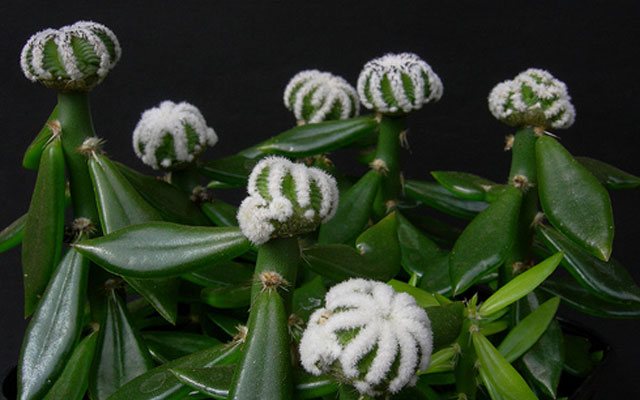

Possible problems
Cereus cactus grows very quickly, and this can create inconvenience in a small apartment.
During the flowering period, the strong smell of flowers can cause insomnia in sensitive individuals.
Cacti of the genus Cereus, grown at home, will decorate any collection of flowers and bring moments of joy
both beginners and experienced cactus growers.
Cereus giant (Cereus giganteus
) grows in Arizona, southeastern California and the Sonoran Desert in Mexico. Cereus giant is the state flower of Arizona, and due to its huge size, one of the Guinness book holders. The fruit of this cactus is regarded as the main element of food, and a unique sourdough is made from the sap of the plant, which contains special enzymes. The resulting product resembles our moonshine and is present at all national holidays.
Cereus giganteus
- plant of the family
Cactaceae
, genus name -
Cereus
... The first description of the Giant Cereus appeared in 1848 and was made by George Engelman. In 1908, in honor of Andrew Carnegie, the genus name was renamed to
Carnegiea gigantean
... The locals call him
sahuaro
and
pitahaya
.
The cactus is a huge column, branched like a candelabrum.The height can reach 18 m (according to some sources, 20 m), the thickness of the trunk-column is 65 cm. The trunk of the plant has from 12 to 24 obtuse ribs with brown areola. The length of the spines of this cactus can reach 7 cm. Leaves are usually absent, they are barely noticeable only in seedlings in the form of small scales.
Favorable conditions for the giant cereus are rocky or gravelly soils located along the foothills or canyons. The plant prefers mainly southern slopes, which protect it from the winter cold. On the western slopes, the height of the cacti is usually less. This is due to seasonal rainfall. Since the roots of Cereus are located in the drainage layers, the soil softens from moisture, and it is quite difficult for a plant to carry a ton (!) To hold on, especially since showers are usually accompanied by strong winds.
As mentioned above, the Giant Cereus is today found throughout the southwestern United States and Mexico. However, scientists suggest that the plant grew earlier in Africa and South America. Its distribution was influenced by the division of the continents 125 million years ago. Naturally, we are talking about the ancient ancestors of this plant. Scientists do not deny the version of the spread of the plant due to the transfer of seeds by birds and insects, therefore there is an assumption that this species could be deserts with favorable conditions in the southwestern United States, in the Great Basin of North America and Northern Mexico, in the Middle East and Africa.
Description:
the stem in nature is up to 12 m high, forms shoots up to 10-12 cm in diameter, with 6-8 flat, roughly dissected ribs. Young Peruvian Cereus are light green in color, while adults are gray-green. As a potted crop, it grows to a height of 1.5 to 4 m. Areolas brown to gray, sparsely arranged. Radial spines 4-6 pcs. up to 1.5 cm long, one central - rigid, up to 2 cm long. All spines are red-brown, needle-like.
The fruit is a spherical, juicy, edible berry up to 6 cm in diameter, from light yellow to orange.
Distinctive feature:
apex with brown tomentose pubescence and light hairs, completely covered with a bluish-green waxy coating.
Under natural conditions, the Peruvian cereus is widespread in South America.
Characteristics and birthplace of the flower
Cereus Is a very ancient and extensive genus of cacti. It unites many varieties and more than fifty species. In nature, these plants are common in India, in the South and Central regions of America.
In nature, a flower can reach more 17-20 meters high, and the duration of its growing season is about three hundred years.
Cereus has a long, branched stem cylindricalcovered with numerous thorns. There are low species, high-growing ones, as well as creeping ones (those that cling to during growth with the help of aerial roots). The cactus grows in hot areas, adapted to arid climate and maybe do without moisture for a long time.
Cereus Peruvian - monstrous form (Cereus peruvianus Monstrosus)
The second name is rocky cereus
... It is the most common type of monstrous cactus and is an example of a natural anomaly caused by a disturbance in the normal growth of a cactus.
Peruvian Cereus with a monstrous form is a fast-growing, unpretentious plant, in nature reaching 5-6 meters in height and capable of growing 5 or more meters in diameter. Light green, with a bluish tinge, the stems form bizarre and unique growths of individual tubercles, outgrowths and fragments of ribs, resembling a rock in their appearance. On ribs and tubercles areola with spiny or needle-shaped spines of brown color.
The species is popular as a pot plant and is often used as a rootstock.At home, the Peruvian cereus never blooms and propagates exclusively by rooting stem cuttings.
In a pot culture, this plant is up to 1.5 m tall and in order to grow it you need:
- plant in a spacious pot with nutritious potting soil;
- place in a sunny and warm place;
- water abundantly during the growth period;
- keep warm in winter.
Fragrant flowers of the cactus Hilocereus undatus (Hylocereus undatus)
We do not often associate cacti with flowers, since most of them bloom extremely rarely and for a short time
... However, many cacti boast very beautiful rare flowers.
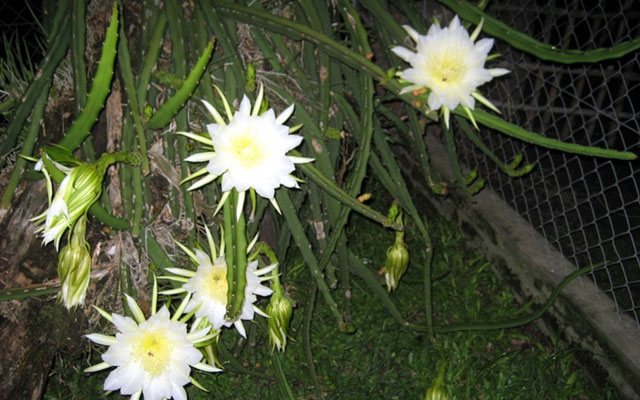

Cactus species Hilocereus wavy
has huge flowers about
35 centimeters
and width
25 centimeters
... In nature, it blooms exclusively at night, and each flower opens only once before giving seeds, after which it dries up and disappears.
10 beautiful but deadly colors
The flowers of this cactus exude a pleasant and incredibly strong vanilla aroma that is simply amazing.


Growing a Peruvian cereus in a pot
In a pot culture, the plant grows rapidly. Cereus Peruvian prefers growing in a soil mixture consisting of turf, leaf, peat soil and sand in a ratio of 2: 1: 1: 1, respectively, with the addition of fine brick chips.
Peruvian cereus cactus in the photo at home.
Should be suitable for the size of the root system and not too spacious. In the warm season, the cactus needs regular moderate watering, but without waterlogging and placement in a sunny place, preferably in the fresh air, at a temperature of + 20-25 ° С. By winter, watering is gradually reduced to a minimum (3-4 times a month), and the temperature of the content must be lowered to + 10-12 ° C.
Cereus propagates by seeds or stem cuttings in early spring.
Growing cereus from seeds
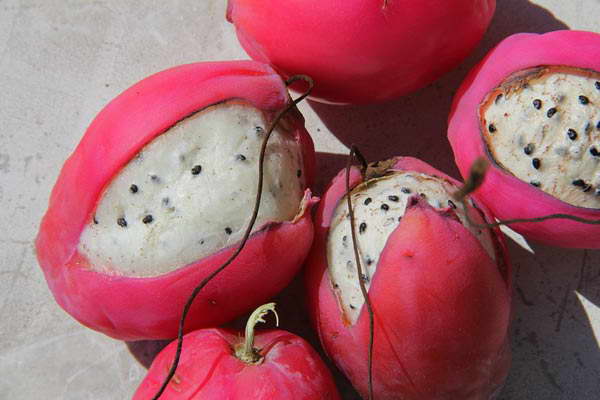

Fruits and seeds of cereus peruvian photo
In nature, Cereus reproduces by self-seeding.
- Use a wide container of cactus growing medium or a mixture of sand and peat.
- Sow in the spring.
- The soil needs to be leveled, sprayed with a fine spray and scattered small seeds over the surface, like salt.
- Germinate with diffused lighting and an air temperature of at least 22 ° C, spray the soil with water as needed, avoiding waterlogging.
- Thin the seedlings with tweezers, protect them from drafts, you can plant them with the appearance of thorns, which will happen after 3-4 weeks.
Cereus Peruvian: houseplant care
The plant is unpretentious, but the Peruvian Cereus prefers care with regular feeding (once every 7-10 days) with special fertilizers for cacti from late spring to mid-summer. It is obligatory to transplant into a larger container young plants (up to 3 years old) annually, adults 1 time in 2-3 years, otherwise the growth will slow down and the plant is deformed. The top layer of soil in a pot should be loosened 1-2 times a month and mulched.
The cactus is resistant to dry air, but regular spraying will benefit the plant.
It belongs to the category of cactus, and generally reaches very large sizes in nature. That is why it is not suitable for cultivation in indoor conditions. The height of such plants in nature can reach from 1.5 m to 20 m. At the same time, the diameter of some species is about 70 cm. And yet there are some species that are grown as a houseplant. They managed to win the love of cactusists with their unpretentiousness and beauty.
Vegetative propagation of cereus


How to propagate a Cereus cactus by cuttings
The easiest way to propagate Cereus by young segments:
- They are carefully broken off by hand, dried until a crust forms and planted in separate pots with soil, as for adult plants.
- They will take root after 2-4 weeks, it is easy to determine - a small cereus will grow.
- You can plant shoots for rooting from spring to mid-summer.
Types and varieties of cereus
Cereus Peruvian.In nature, its height reaches 12 m, but in an apartment it grows up to 1.5 - 2 m. It blooms with white flowers about 20 cm long and about 10 cm in diameter. But the aroma of flowers is not pleasant. The stem has 6 to 8 separated ribs. After flowering, fruits appear in the form of a ball. The diameter of the fruit is about 6 cm. It can bloom in all shades of yellow and orange.
Monstrous cereus
Cereus monstrous (rocky). Has a very unusual and all kinds of shape. In natural conditions, it can grow up to 6 m. But at the same time, the stems are branching and beautiful, with a blue tint and with unequal ribs. In indoor conditions, the height is not more than 1.5 m.
Cereus mammillaria
The shape is spherical or cylindrical. Small to medium size. The cactus has no ribs, but there are papillae located in a spiral. It blooms with burgundy, saffron, snow-white fluffy flowers.
Cereus Strauss
The domesticated plant will grow up to 1 m, about 15 cm thick. The shape is columnar with a large number of tiny white needles. The flowers are tubular, not large, with burgundy or brown hairs.
Botanical description
This plant is a large tree-like shrub with a well-developed root system. Its trunk can be green with a blue tint. The surface is covered with numerous sharp ribs. In the middle part of the areoles, there are villi and spines of a gray, red or brown hue.
During the flowering period, flowers form on the shoots in the form of funnels up to 20 cm long. After drying, red or yellow berries develop in their place, which can be eaten.
Home care
Temperature conditions. Since the cactus is in a dormant state in winter, the temperature should be between 8 and 12 °. The content is dry. In the summertime, the cereus can be taken out into the street or on the balcony.
Lighting
In summer and winter, bright lighting is required, as the flower needs a powerful amount of light. But by the spring and summer direct sunlight it is necessary to "train" a little. Otherwise, burns may remain. Still, it's worth saying that some cactus species require direct sunlight, while others require diffused light. The best place would be a south-east or south window. Lack of light can be seen by the way the sprouts stretch and become thin.
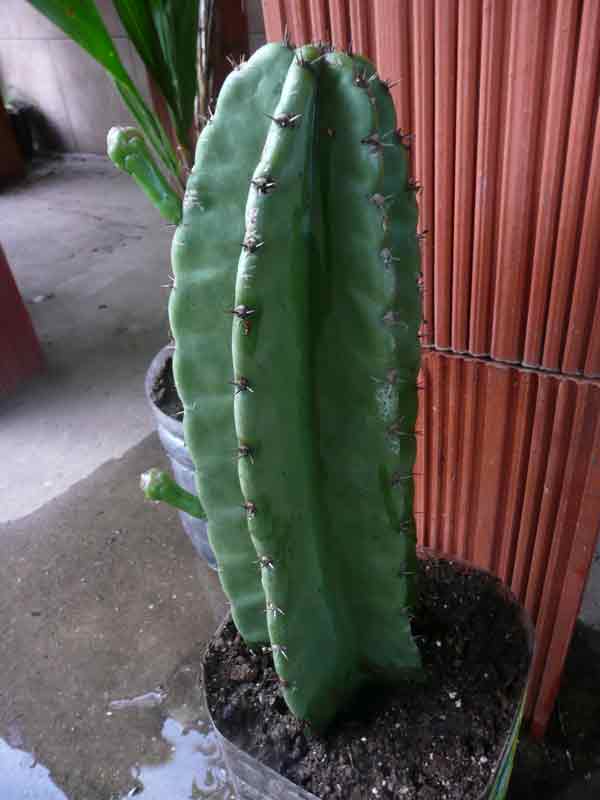

Watering the cereus
In spring and summer, watering depends on weather conditions, but mostly moderate. If the summer is hot, then you need to water the cactus every day. Starting in autumn, they are gradually reduced, and in cold weather, watering is practically stopped. In this case, the content should be cold. The stems cannot be watered. It is enough to spill the edge of the pot with a watering can. Water stagnation inside the pot must be eliminated. If watering is carried out from the pallet, then after a while the remaining water is drained.
The frequency of irrigation depends on the temperature and humidity in the room. Therefore, the lower the temperature, and the correspondingly higher humidity, less watering.
Fertilizing cereus
By their nature, cacti grow very quickly, therefore, from spring to mid-summer they need to be fed. In specialized stores, you can buy fertilizer designed for cacti. It contains all the necessary batteries. In particular, potassium, which is a vital element. It promotes the growth and formation of a hard canopy. Potassium also helps the sprouts ripen at the right time. In addition, potassium is a stimulant for good flowering. With its lack, there is no flowering, the cover is pale, and sometimes with a bronze tint.
Phosphorus activates the growth of roots, and also affects the setting of flower ovaries and further flowering. The lack of phosphorus is noticeable by the slow growth, even if the light and temperature conditions are observed.
Calcium is responsible for the growth and condition of needles and hairs. If this element is not enough, then the thorns will be soft, and the plant will be fragile.
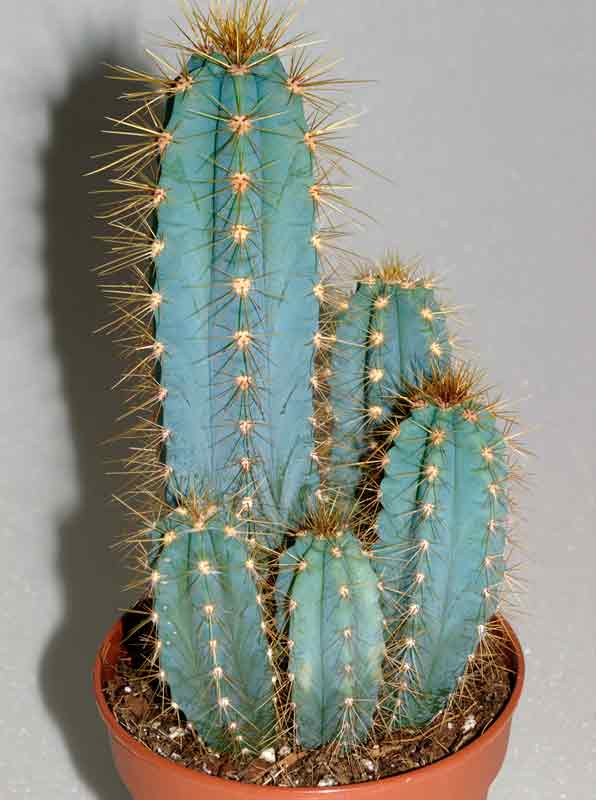

Air humidity
Despite the fact that cacti are resistant to drought, in particular to dry air, it is very useful to spray them with warm water.
Growing a cereus: basic requirements
Like most cacti, cereus are unpretentious in terms of maintenance and care. But there are some recommendations that a beginner cactus grower should take into account.
The soil
For good growth and development, cereus needs acidic or neutral soil; in an alkaline environment, it will not survive. If you are preparing the substrate yourself, add river sand and crushed brick to it. When buying a ready-made composition, you should stop at a soil mixture for cacti or succulents.
Lighting
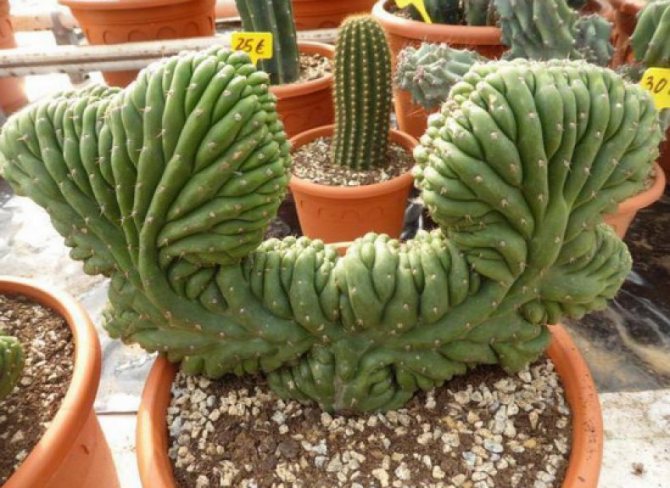

Monstrous forms will also have to be supplemented at least sometimes.
For flowering, the plant needs abundant light all year round. This is especially important in the cold season, when buds are tied on the cactus. There are several rules:
- the container with the plant should stand on the window from the southeast or south side (where there is more sun);
- diffused light is required, since direct rays of the sun can leave burns;
- in autumn and winter, cacti must be illuminated with phytolamps (daylight hours should be 10 hours);
- after winter, the cereus should gradually get used to the bright spring sun, and at lunchtime in summer, the cactus should be hidden under a tulle curtain.
Air temperature
The cactus tolerates heat well, but at the same time it needs regular ventilation. In summer, it is better to keep it on an open balcony or veranda; from late autumn until spring, the indoor air temperature should be maintained from 8 to 12 ° C.
Cereus transplant
The optimal soil will be: 1 portion of sand, peat, leafy soil and 2 portions of virgin soil. The most optimal time for replanting is late spring and early summer. This is exactly the time when the cactus comes out of the state of winter dormancy. Although transplanting is allowed during the period of active life. If a healthy plant is transplanted, then the size of the new pot should be slightly higher than the previous one. If decaying or dead roots are found, they must be cut off. It is important that the pot is slightly smaller than before. Sand and lump charcoal should be added to the soil. If the cactus grows slowly and the roots grow poorly, they are transplanted into an old pot, but with the replacement of the soil.
It is also important to disinfect the pots and soil. The pot is poured over with boiling water, and the soil can be calcined for about half an hour in the oven. The plant is not watered for two or three days before transplanting to prevent root breakage. The soil should not be wet, in extreme cases slightly damp, but rather dry.
For the convenience of transplanting cacti, the plant is wrapped in a strip of paper laid in several rows. The cactus pot is turned over and, tapping on the bottom, carefully removed.


Care
Lighting
Cereus cactus is very fond of sunny colors. It is recommended to keep it on a loggia or balcony in the south, southeast direction. Sunlight should be present in sufficient quantity at any time of the year. If in winter there is not enough light, you can use special phytolamps.
It is noted that the cactus can get burns in the summer. In order to prevent the plant from burning, it is required to gradually accustom the cactus to sunlight after the winter season.
Temperature
Cereus, not whimsical to the temperature regime. Quite hardy and tolerates heat, without any consequences. However, there are certain requirements:
- In winter, the plant requires an optimal temperature regime, as a rule, this regime is 8-10 degrees.
- During warmer seasons, it is recommended to keep the plant outdoors more. The temperature regime in the spring-summer period (15-30 degrees) the cactus tolerates favorably.
Watering
- Cereus should not be watered with hot or cold water, warm water is optimal. So, it is not recommended to use soft, settled water;
- Watering should be moderate in the spring and summer;
- In the fall, watering should be gradually reduced in preparation for the winter season.
- In the winter season, the cactus should be watered rarely, watering is reduced to once a month. The cactus should not be waterlogged, excess moisture is detrimental to the plant. Due to waterlogging, it can rot.
Humidity
An aspect such as humidity is very important for cereus. It is recommended to spray the plant with clean and warm water during the warmer months of the year. Spraying will help him to endure hot days and accumulate the required liquid without waterlogging.
The soil
The soil should be neutral or acidic, but not alkaline. When creating soil on your own, it is imperative to include a small amount of fine brick chips and river sand in the composition. Soil with a large amount of humus is not suitable for Cereus.
If the soil is purchased, then you need to purchase soil intended for cacti and succulents.
Fertilizers
Top dressing for cereus falls from mid-spring to mid-summer. It is recommended to use liquid fertilizers, according to the instructions. In summer, the cactus grows actively, it needs special trace elements for healthy development.
Dormant period
The dormant period occurs in the winter. It is recommended to place the cactus in a bright and warm place. No feeding is required at this time.
... And watering can be reduced to once a month (but it is better not to water at all than to water more and more often).
Transfer
The first transplant is carried out when the plant is still young. It is required to change the pot to a wider, but not deep one. Mature plants need to be replanted every two to three years. For transplanting, they take a not deep pot, a drainage layer is laid on the bottom. Drainage can consist of expanded clay or pebbles. At the bottom of the pot, there must be holes that serve as drains for water.
Suitable soil can be purchased from the store for succulents and cacti. The soil should be neutral or slightly acidic.
Reproduction
The cactus is propagated by cuttings or seeds. If you plan to propagate the plant with seeds, then it is better to sow them in a mixture of sand or fine-grained gravelite with a size of 2 to 4 mm, as well as activated carbon in granules. All this is taken in equal proportions. You can also add vermiculite or sorbitol about 1/5 part.
For sowing, seeds can not be used construction sand, because over time it is strongly compacted and cemented. It is recommended to use fine river sand.
The seeds are germinated at a temperature of 25 to 33 °. The container with crops must be covered with a transparent film and regularly ventilated, while the condensate from the film must be shaken off. As soon as the seedlings sprout, you need to create additional lighting, because even on a sunny window it will not be enough. Lamps can be LED or fluorescent. They are located at a distance of at least 5 cm from seedlings.
Peyote cactus (Lophophora williamsii)
One of the most well-known cacti - Lofofor Williams
- or, as the locals call it,
cactus peyote
... This cactus
forbidden to grow or store
, since it has a psychotropic effect due to the high concentration of the narcotic substance
mescaline
.
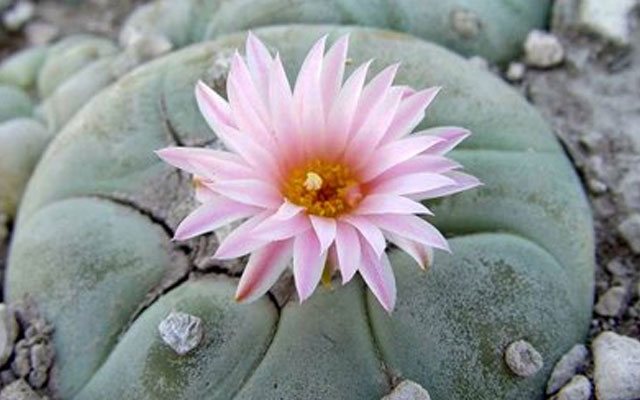

This cactus is allowed to be used exclusively Native American tribes
as they have been using this plant since time immemorial and it is an integral part of their rituals. According to these tribes, the use of Peyote allows them to communicate with spirits and other otherworldly beings.
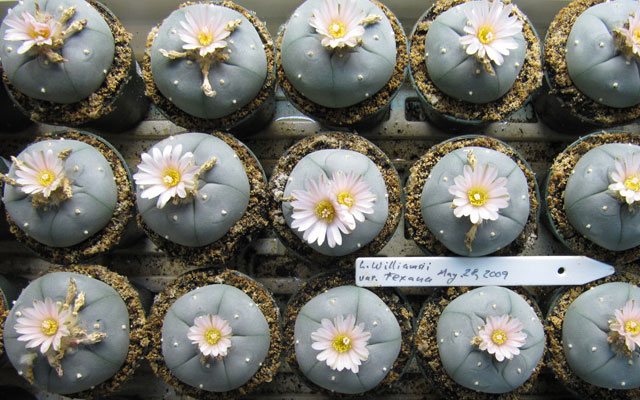

Diseases and pests of cereus
Rot
The most common disease. The reason for its appearance may be excessive watering, low wintering temperature. If rot is found in the root system at an early stage in the development of the disease, all infected roots can be trimmed off. Treat healthy ones with coal mixture or sulfur. Also, if the whole root is infected with a disease, it can be saved.In this case, it is possible to save the upper fragment. It is rooted with a handle. But it is important that when cutting off the shoot, intact fragments are preserved.
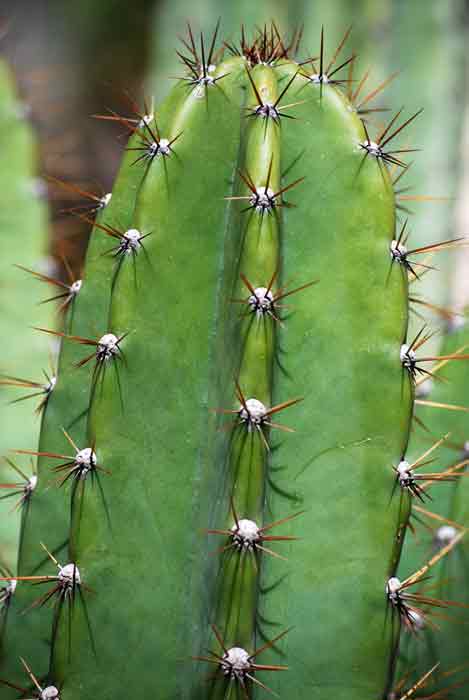

Black rot
The disease can be seen on the trunk. These are black or dark brown plaques. They can be wet, glossy, and nasty looking. To prevent further spread of the disease, plaques are excised to a healthy part. At the same time, it is important to sprinkle the cut points with sulfur or spray with Fundazol, Hom, Oxykhom.
Agave cactus (Leuchtenbergia)
Cactus species Leuchtenbergia principis
is the only member of its genus and has smooth, finger-like protrusions that attach to the main stem. These "fingers" at the tips have
small bunches of spines
, which in more mature plants grow together and form an intricate protective web around the cactus.
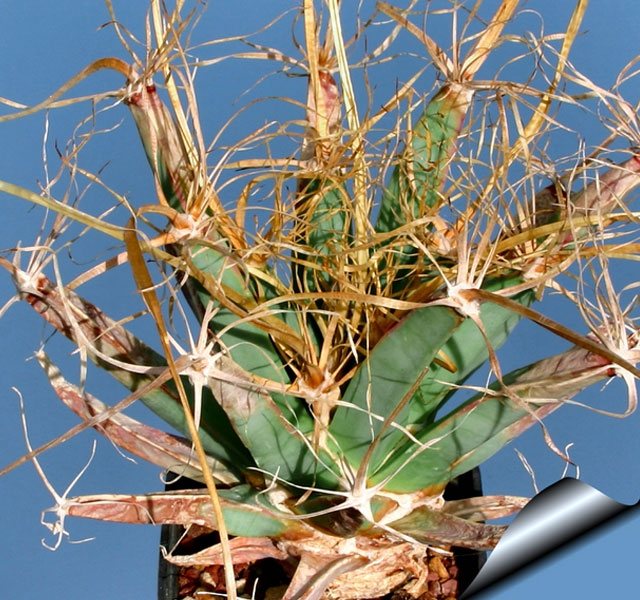

Agave begins to grow like a regular cactus, but later acquire this feature. Once the protrusions have formed, the cactus maintains their shape, becomes wider and stronger, while remaining one whole plant
... This is not entirely normal for cacti, as they usually produce many babies at certain stages of development.
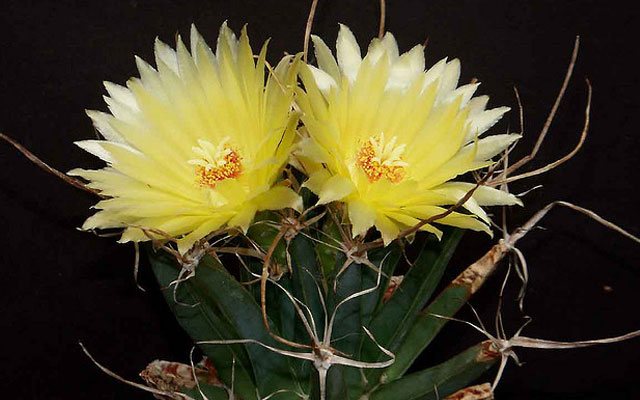

What it looks like and where it grows
A succulent of the cactus family. Withstands periods of drought due to the accumulation of moisture in the stems. The homeland of the cactus is the territory of Mexico, the West Indies, and the South of America. The name translates as "wax candle", which corresponds to the appearance of the cactus. The number of species in the genus has not been established.
Cereus are centenarians. Their age reaches 300 years. Close to a tree-like form - branches, bushes. The minimum height of natural species is 1.5 m, the maximum is 20 m. It has a powerful root system. Ribs are high, pointed, straight, from 4 to 8 pieces. Areoles are large, with a felt covering. Radial spines are hard, strong, up to 3 cm long.In the center - awl-shaped up to 10 cm.
Interesting! Cereus is grown in apartments due to its rapid growth. It is an excellent rootstock for increasing the stamina and resilience of other cactus species. Designers often use the plant to decorate shop windows, winter gardens, and create spectacular compositions with other succulents.
In nature, it blooms in May or the very beginning of summer. Many species open flowers at night. Location - lateral, on the lateral parts of the stem. The flowers are large, often white with a yellow core. The smell is strong but pleasant. Some flowers have a vanilla aroma.
On a large wild-growing cactus, up to 10 flowers can bloom at the same time. Flowering does not last long - the flowers wither within a day. It is very difficult to achieve mass flowering in an apartment. It is believed that the flowering of the sireus is a great success. But the plant just needs favorable conditions - a long daylight hours, the correct period of rest. There are several reasons for the lack of flowering:
- Insufficient lighting.
- Lack of a dormant period or violation of the recommended conditions for keeping in winter.
- Young specimens do not bloom.
- Rare airing, wrong watering regime.
For flowering, a well-lit place is required, additional lighting as needed. The plant must receive the right amount of moisture, winter calmly at low temperatures. The timing of flowering in an apartment depends on the conditions of detention. The cactus blooms in late spring, summer or fall. After flowering, the fruit ripens red or yellow. The size of the fruit is up to 10 cm. The surface is smooth, on the tip there are remnants of a flower pistil. The fruit is edible and smells good.
Peruvian Cereus
This is the most common species in the genus. Under natural conditions, it grows up to seven meters in height. The trunk reaches a volume of 90 cm, and then begins to branch abundantly. Branches, as a rule, are from 10 to 12, up to 30 cm in diameter. They are covered with a bluish bloom. Areoles of young plants consist of a small number of centimeter thorns, which are located quite rarely: on a new growth, the cactus is practically thornless.Older shoots have many more thorns. Large nocturnal white flowers reach 15 cm.
The Peruvian Cereus has a long, cylindrical stem. The duration of the growing season is up to three hundred years. As an ornamental garden and indoor plant, the Peruvian cereus is widespread in many countries of the world. Lovers of this species appreciate it for its juicy fruits with a delicate delicate aroma. They are used as a powerful and reliable rootstock. In indoor culture, the most common cactus is the Peruvian monstrous or rocky Cereus. We will talk about it further.


General description and origin
A cactus of this variety in natural conditions is able to grow into a real giant. You can even say that this is the largest cactus, since it is able to grow to a height equal to the growth of a person and even higher. There were specimens that grew up to 6-10 m in height. Some plants even became champions, since their growth was 20 m. However, at home, these compact flowers are rather compact in size.
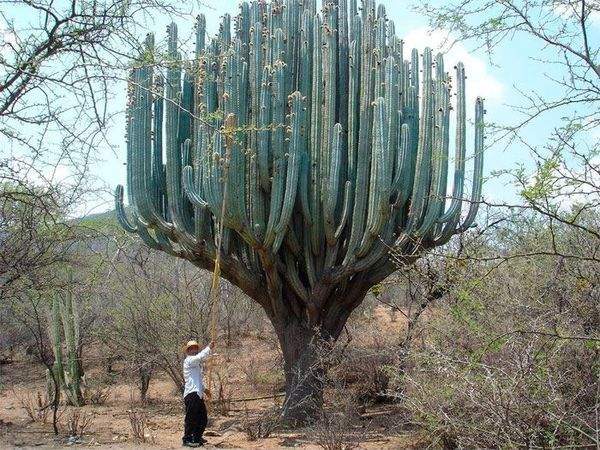

All representatives of the subspecies Cereus are long-livers. In natural conditions, they grow in Western India, as well as in Central and South America.
The name "Cereus" is translated from Latin as "wax candle". A huge cactus is fully consistent with its name: these plants have not very wide shoots elongated in height. The size and appearance of the flower directly depends on the variety.
How I got vaccinated
Prepared the baby. I found a good sprout of the cereus so that it grows a little to the side. I prepared a thin elastic band that is used in sewing. Stocked up with a sharp knife with a thin blade. Everything must be done very quickly so that the juice on the slices does not dry out. The rootstock and the scion must be of the same diameter.
She cut off the top of the cereus process. Then she cut off the "ass" of the baby Echinopsis and quickly put them together. She fixed them firmly with an elastic band. That's all. I checked the result of my experience only two months later. I took off the rubber bands and saw that everything worked out on one branch!
Necessary conditions for growing
You need to grow a flower on neutral or acidic substrates. The pot must contain sand or brick chips. It is forbidden to grow such plants on nutrient soils that contain a lot of humus.
To achieve flowering from a cactus, Cereus care must be correct. In an apartment for this flower, you must create the following conditions:
- illumination. This is a light-loving culture. Therefore, in the cold season, the cactus must be additionally illuminated. The plant should be grown on windows facing south or southeast. In spring and summer, direct sunlight can cause burns. To avoid this, the flower should be gradually accustomed to direct sunlight;
- temperature regime. In winter, the cactus should be kept at a temperature of + 8… + 12 ° C. The plant is not afraid of spring and summer temperature jumps. From summer to autumn, you can keep a flower pot on an open veranda or balcony;
- humidity. In spring and summer, the cactus must be additionally moistened. To do this, it is sprayed with warm clean water.
In addition to the conditions listed above, when growing Cereus at home, you need to know the features of caring for it.
Watering
There is an opinion that watering cacti is not necessary, they say, they grow in their own desert! But do not forget that it gets cool at night in deserts and savannas, and morning dew is the life-giving moisture that is needed for its growth. But the air in the apartment is dry. Therefore, cacti are regularly watered in summer. It is better to water in the evening, when the sun does not heat the pot too much. On hot days, it is recommended to spray the cereus. And the dust that settles on its prickly sides is easily swept away with a regular paint brush!
Cereus loves watering in summer. But this does not mean that it must be filled with water.Its root system will not withstand such care. From the constant overflow, the cactus stem begins to rot right at the ground and then the whole plant may die.
With the onset of autumn, watering should be gradually reduced, preparing the cereus for winter "hibernation". Cereus has winter - a dormant period. At this time, it is practically not watered. And kept in the coolest place. You can simply move it closer to the window, and so that the warm air from the battery does not fall on the cactus, it is fenced off with cardboard or simply put in a box. Large specimens can be watered once a month, if the temperature regime is observed. Only very small plants can be watered a little once every one to two weeks so that they do not dry out over the winter. And in the spring it is also necessary to gradually increase watering.
Rare cactus Obregonia denegrii
This rare cactus, nicknamed cactus artichoke
, is the only representative of the genus
Obregonia
... Like other types of cacti,
Obregonia
has thorns that fall off quickly. The stem of the cactus is covered
triangular fleshy papillae
, which makes it outwardly very original.
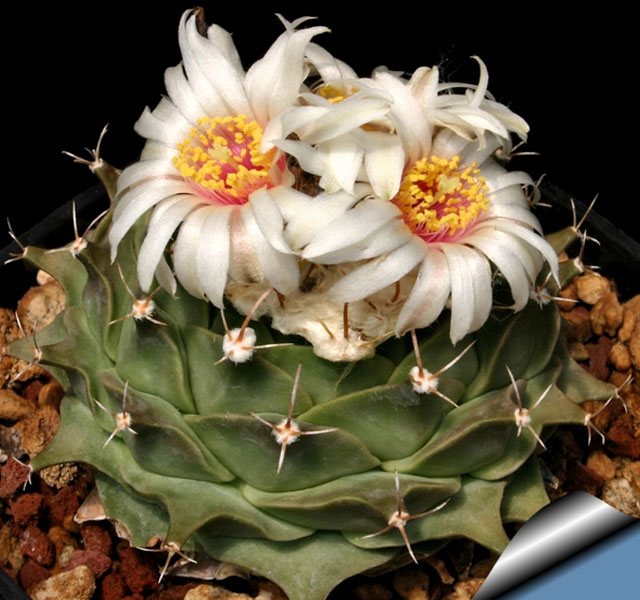

Cactus shape by something resembles an artichoke
, hence the name. Small flowers appear at the very top of the head in summer, and after flowering, the cactus produces edible fleshy fruits.
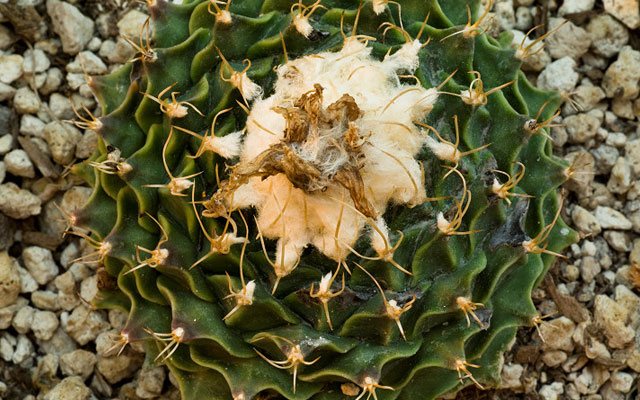

Growing
It is not difficult to grow a Cereus at home, since the plant does not require special care. It is enough to adhere to the basic rules for keeping thorny plants.
Lighting and location selection
Like any cactus, Cereus loves light. It should be sufficient both in winter and summer. The best place in the house for him would be a light windowsill on the south or east side.
Important! Direct sunlight should be avoided, as they can burn the trunk of the plant.
To prevent this from happening, Cereus should be gradually accustomed to the sun after winter, exposing it to the window for several hours and gradually increasing the time of exposure to the sun. You can also use window blinds and use them to regulate the amount of light.
Substrate and fertilizers
In order for cacti to grow well, they need to be fed regularly. It is better to do this in the spring and summer. For feeding, fertilizers are used in liquid form. You can also dilute the granular fertilizer in water and water the plants. Transplanted cereus plants do not need feeding for up to a month, since the new soil contains all the macronutrients they need.
The transplant substrate is selected with a neutral or acidic composition without alkali. Sand and brick chips must be added to the mixture. The soil for cacti should contain a minimum amount of humus.
Temperature
Cereus is not afraid of temperature changes. In winter, he feels great at + 13 ... + 16 ° C, and in summer it can withstand up to 40 degrees of heat. The most comfortable temperature for a cactus is 24 ... 26 ° C above zero.
Humidity and watering
Water the plant with warm soft water. In spring and summer, moderate watering is recommended once every 10 days, and in the winter months, it is enough to refresh the cactus just once every 4 weeks.
Important! It is categorically not recommended to fill in the cereus, because as a result of waterlogging, it can get sick and disappear.
In the summer, cacti should be sprayed with warm water from a spray bottle to provide it with the required moisture level. A comfortable condition for their growth is considered to be a humidity of 30-50%.
Transfer
Cacti do not need a special transplant. This procedure is carried out only when necessary, when it is necessary to plant overgrown specimens. This can be done no more than once every 2 years. This will require a spacious pot and fresh soil.
Cacti also include hatiora, epiphyllum, ripsalis, echinocactus Gruzoni, hymnocalycium, Decembrist flower, prickly pear.
Reproduction
Reproduction of cereus occurs in two ways:
- seeds (this method is more typical for species growing in the wild, but also used at home);
- by cuttings.
Cuttings are practiced in the spring and until mid-summer.For this, young shoots are cut, slightly dried and planted in a small container with a substrate. Roots appear after 30 days. After that, it is enough to transplant the plants into pots.
Also propagated by cuttings: petunia, chrysanthemum, pelargonium, azalea, clematis, brugmansia, thuja, laurel, dogwood, mulberry
Diseases and pests
Cacti, like any other plant, are susceptible to disease. In order to detect them on time, it is necessary to carefully examine the cereus once a week for the appearance of unusual spots. They often indicate improper watering or insect infestation.
Among the dangerous pests are:
- spider mite;
- mealy worm;
- false shield;
- shield.
mealyworm. mite
Scabbards (small bugs) are easy to see with the naked eye on the stem of a plant. They parasitize by sucking the juice from cacti. In order to get rid of pests, it is enough to water the cereus with a special insecticide.
Another problem faced by members of the cactus family is rot fungus. If the affected area is small, it can be removed, and the incision site should be treated with an alcohol solution. In this case, watering must be stopped until the plant recovers.
Did you know? Cacti have more than 2.5 thousand varieties of this family.
Possible problems
In addition to parasites and the problems they provoke, the owners of the cereus may face difficulties of a different nature. There are times when cacti don't throw out flowers.
The reasons for this phenomenon:
- poor lighting;
- non-compliance with the temperature regime;
- improper watering;
- the plant has not reached the age required for flowering.
You will probably be interested to know what useful properties a cactus has.
It is pretty easy to grow beautiful flowering cereus. To do this, it is necessary to provide the plant with light, warmth and timely care. Then the cactus will delight you with a fragrant aroma of snow-white flowers.
How and when to transplant Cereus
If the cereus is already old enough, then it can not be transplanted for 3-4 years. And they are transplanted when the roots have already begun to crawl out of the holes in the flower pot or the cactus has stopped growing due to overflow or disease.
The simplest earth is suitable, with an admixture of sand. But it must pass water well. You can immediately buy cactus soil at a flower shop.
Before transplanting, the cactus is not watered.
The pot for the transplant is taken a little more than the previous one. It is desirable that it be with a wide base, since the cereus grows well, and over time it can turn the pot over under the weight of the growing stems.
Prepare disposable gloves, a kitchen mitten and oven mitt, a thick sheet of paper, a knife or a flat spatula. Wear gloves.
Pour expanded clay at the bottom or crumble pieces of foam. I take both in half.
Spread a thin layer of earth.
In an old pot, remove all pebbles (if any) from the surface of the earth.
With a knife or a spatula, hold between the walls of the pot and a lump of earth so that the cactus can be pulled out of the pot.
Put on a mitten on one hand, and take paper in the other hand. Tilt the cactus onto the paper, holding it by the base, and pulling the pot with the other hand.
Of course, it is better to do this procedure together. Examine the roots. If there are rotten ones, then they must be cut off and sprinkled with charcoal. Place the cactus in a new center pot.
But if it grows on the side in a coma of earth and nothing can be done, then you can leave it that way.
Pour the earth along the edges of the pot, tamp on the sides.
The pot is filled with earth to the top, since after watering the earth will still settle.
But you can't water the cactus right away. We have to wait five days. Pebbles that have been removed from the old pot must be washed and placed in a new pot. The transplant is over.
Uses of Night Cereus
Cereus jamacaru is a hardy rootstock and grows quickly. Therefore, it is widely used for landscaping winter gardens, greenhouses.They decorate the halls of premises, shop windows with it. They also create decorative cactus slides. Pillar-shaped specimens are used to make a live thorny hedge. Low-growing options are placed in apartments on window sills. Cactus wood is used to make polished ornaments and fine items. Barrels are also actively used as fuel and building material.
Growing problems
When growing cacti, it is necessary to carefully water the plants so as not to overmoisten and to avoid rotting of the roots and base. Cereus is a cactus that is not particularly vulnerable to disease. Disease prevention is frequent ventilation, rational watering, and a sunny place. Cereus will feel great in the summer on a sunny balcony and terrace.
Of the pests, mealybugs pose a threat, feeding on plant sap, bringing the plant to yellowing and stunting.
Structure
The cactus is characterized by a shrub structure (branches in the lower part). In its natural habitat, it reaches several meters in height, in domestic cultivation, the height is limited to one meter. Fleshy, branched, greenish ribbed stems. Usually about 7 ribs, the number can vary from 5 to 8. On the stem of each halo, there are numerous spines with one dominant. Mature specimens produce large flowers, up to ten centimeters in diameter. After flowering, coral-colored edible fruits appear.
A particularly popular variety of Peruvian cereus "Monstrosus" of irregular shape with numerous branches. The wrinkled plant looks original.
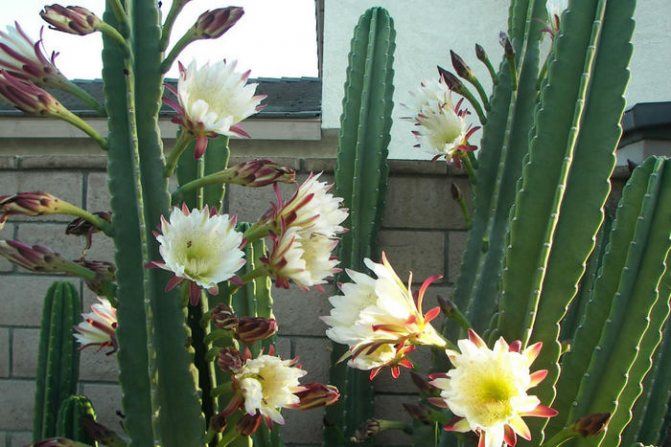

Cereus as rootstock
For lovers of cacti, cereus is just a godsend! It can serve as a stock for those cacti that have a very capricious root system or cacti grow very slowly. If you plant any other cactus on the cereus, you can improve the growth of a capricious plant and even get a different color of flowers.
Grafting is not difficult at all. I first tried it for the sake of experiment. I took three children from Echinopsis and performed this procedure according to all the rules. Two children did not take root, but one successfully grew and put down roots. This baby is already a year old, she has doubled in size.
Reproduction nuances
In the wild, Cereus reproduce by seed. Florists use the simplest method - cuttings.
Cuttings are harvested in the spring. To do this, a healthy and tall shoot is cut into pieces, which are dried for 3-4 days. The seedlings are slightly deepened into the loose and moist soil. The first roots can be seen after 2-3 weeks. After another couple of weeks, they can already be placed in separate pots.
The seeds are sown in the tank in mid to late spring. For this purpose, loose soil with the addition of sand is more suitable. Seedlings are watered abundantly and kept in a shaded place until the first shoots appear. Then the culture must be rearranged to a lighted area where the temperature does not drop below 19 degrees. A pick is carried out after small thorns appear.
Plant varieties
Today, there are many subspecies of this flower in the world (for example, the San Pedro cactus, steel, Peruvian, etc.). Consider the most popular varieties of Cereus.
Peruvian
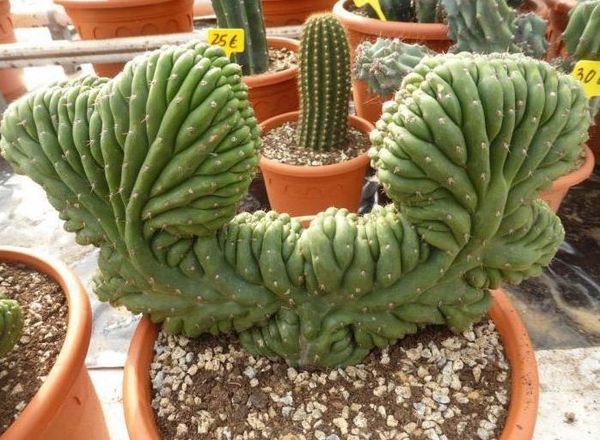

Among the huge representatives of this species, it is worth noting the Peruvian Cereus cactus. Its second name is the Rock cactus. The plant has a gray-green stem, which is characterized by a cylindrical shape. Moreover, in this subspecies, distinctly distinguishable ribs are formed on the shoot.
Despite the fact that in the wild this is a large flower, in an apartment it can grow up to a maximum of 100 cm. This representative of the home flora blooms with white flowers that exude a pleasant aroma. The buds open at night. After flowering is complete, a fruit is formed in their place - an orange or red berry. You can eat it.
Azure
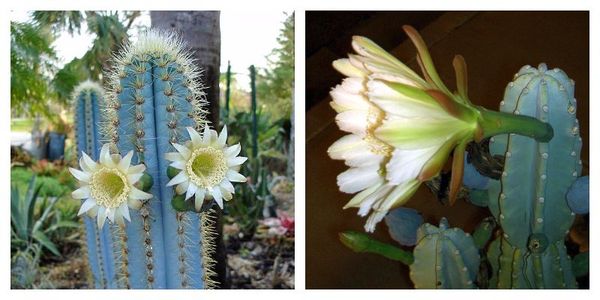

This variety got its name from the unusual blue color of its stem.The plant is covered with a silvery-bluish bloom. The shoot is highly branched, forming poorly distinguishable ribs with tomentose or wavy edges. Cereus azure blooms with fragrant white flowers.
Brazil is considered the birthplace of this subspecies. The plant has treelike features. A distinctive feature of the cactus is the formation of lateral stems. Many spines are formed on the shoot, which are located radially. Usually their size is 1 cm. This is a rather tall flower. It can grow to a height of 3 m. At home, the maximum flower length is 20–25 cm, and the diameter is 8–10 cm.
Cereus strong


In the wild, it is found in Argentina and Bolivia. Outwardly, the plant looks like a shrub that grows to a height of 2 m. This is not the largest specimen, but one of the most branched. The flower forms about 5-8 shoots, which are located on the sides of the main stem. Shoots are colored bluish green or light green. Its ribs are usually about 4-8 units.
The stem has radial spines (3-5 units). They are painted yellow-gray. The spines are hard and grow 2 cm in length.
During flowering, Cereus strong cactus forms red or white buds. After the flowering period is over, the plant forms a fruit with white or red flesh.
Spiral
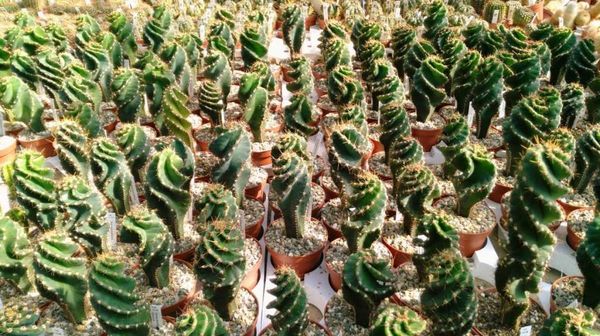

It is a perennial flower that forms a fleshy stem. Usually the shoot has a spherical shape. But there are relief or flat specimens. Usually no leaves form on the stem. But there are a lot of thorns on the shoot. Their length is about 2–3 cm.
White-pink flowers are formed on the sides of the shoot. They are quite large and have a beautiful appearance.
Steel


This variety can grow up to 10 cm in diameter. The main stem forms lateral processes. It is usually colored pale blue or bluish green. Indoor representatives of this species are 10–20 cm in diameter. The ribs are straight, placed high. There are about 6-8 of them. Areoles are light gray.
Brown spines are 2-3 cm long. Their number can reach 20 pieces.
During the flowering period, the plant forms 1-2 buds. They are white-green and can be 20 cm long. The cactus bears fruit with dark carmine fruits.
Cactus Turbinicarpus (Turbinicarpus subterraneus)
When we talk about cacti, we usually think of a round or oblong fleshy thorny plant
, however, some representatives of cacti can boast of an unusual shape. For example, a cactus of the species
Turbinicarpus subterraneus
- a real surprise, as its green body grows on a long stem.
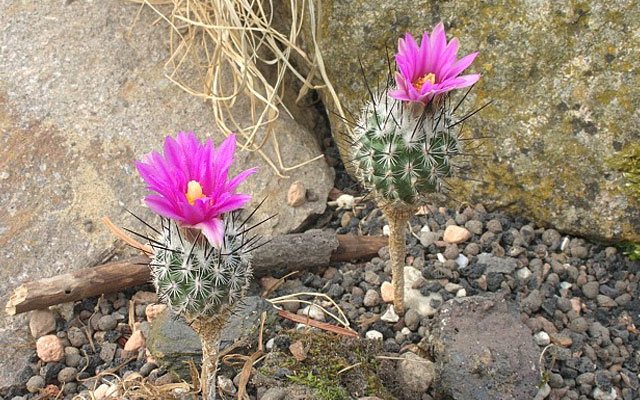

The tuberous root, which is located underground, is approximately the size of the green body of a cactus and allows the plant stay without water for a long time during periods of drought
, storing large volumes of liquid. Since the body of the plant itself is above the surface of the earth, this cactus is able to withstand frosts down to minus 4 degrees Celsius.
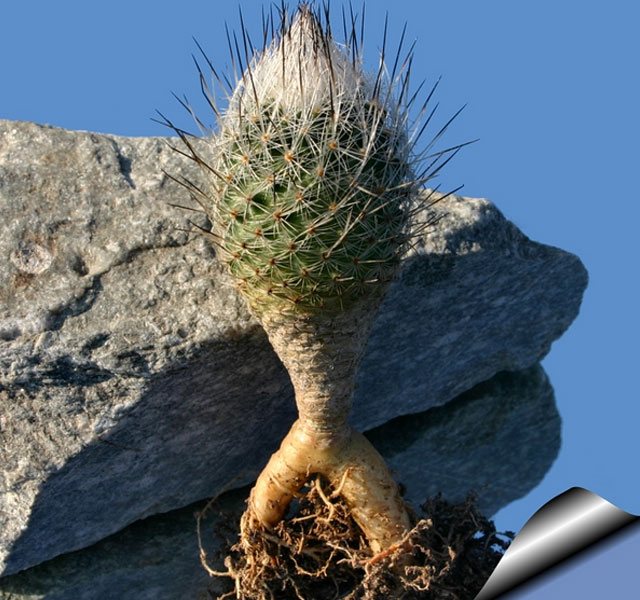

The smallest cactus Blossfeldia tiny (Blossfeldia liliputana)
Often found in the Andes mountains, a cactus of the species Blossfeldia liliputana
got its name from the land of the Lilliputians from the book about the adventures of Gulliver. This cactus is
the smallest type of cactus
whose diameter is
maximum 1.3 centimeters
.
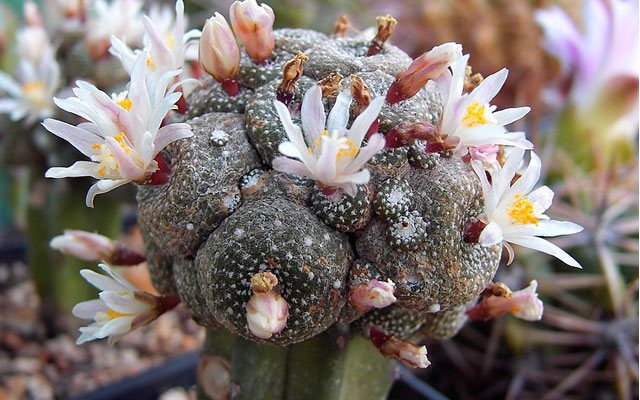

Its size and developmental features make this plant unique. Cacti of this species bloom in the summer and pollinate themselves
... Then they give seeds, which are so small that they are easily carried by the wind.


Lighting
Cereus Peruvian, for which home care requires bright, good lighting throughout the year, also prefers sunny places in natural conditions. It is advisable to place the plant on a southeastern or southern windowsill. Cereus is very fond of sunlight, including direct sunlight, but in summer and even in spring there is a danger of burns.To preserve the plant, it is necessary to accustom it to the sun in a dosage, gradually after winter.
